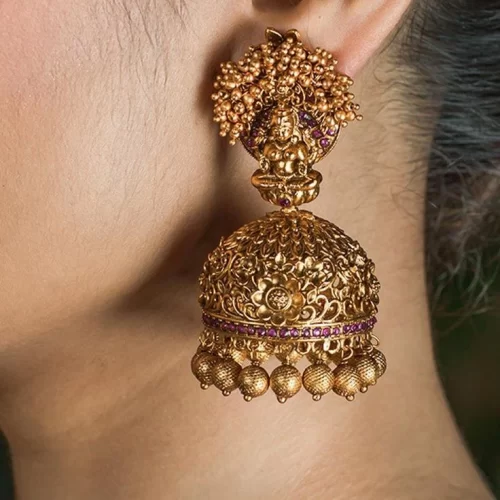Unveiling the beauty of Temple Jewellery
Jewellery is an integral part of Indian culture and tradition. It has a rich history and has been a symbol of wealth, status and spirituality. One of the most popular styles of jewellery in India is temple jewellery. It originated in South India and has a unique design and cultural significance. In this blog, we will delve into the history, design elements, types, and contemporary use of temple jewellery.

History of Temple Jewellery
The history of temple jewellery can be traced back to the Chola dynasty, which ruled South India from the 9th to 13th centuries. The Chola rulers were great patrons of the arts, including jewellery making. They commissioned intricate pieces of jewellery to adorn the deities in their temples. The jewellery was made of gold and featured intricate designs, often depicting scenes from Hindu mythology. The Chola craftsmen used the lost wax casting method, which is a traditional technique of casting metal into shapes using a wax mould. This technique allowed them to create intricate designs with fine detailing. Over time, temple jewellery evolved to be worn by classical Indian dancers, who wore it to enhance their performances.
Design Elements of Temple Jewellery
Temple jewellery is characterised by its intricate design elements. It typically features motifs of deities, animals, birds, and flowers. The jewellery is often made of gold and is adorned with precious stones such as diamonds, rubies, emeralds, and pearls. The designs are often inspired by temple architecture and feature intricate filigree work. One of the most popular motifs in temple jewellery is the peacock, which is considered a symbol of beauty, grace, and royalty. The designs are often asymmetrical, with intricate detailing on one side of the piece.
Types of Temple Jewellery

Temple jewellery includes a wide range of pieces, including necklaces, earrings, bracelets, bangles, waistbands, anklets, and hair ornaments. Some of the most popular pieces include the temple necklace, which is a long, beaded necklace with a central pendant, and the jhumka, which is a bell-shaped earring. The waistband, known as the vaddanam, is another popular piece of temple jewellery. It is worn around the waist and features intricate designs, often depicting the goddess Lakshmi, who is associated with wealth and prosperity.
Contemporary Use of Temple Jewellery
In recent years, temple jewellery has become popular in fashion. It is worn as a statement piece, often paired with traditional Indian clothing such as sarees, salwar kameez, and lehengas. Temple jewellery has also been incorporated into contemporary designs, with designers creating pieces that blend traditional and modern styles. The use of temple jewellery in fashion has helped to keep this traditional art form alive and relevant.

Caring for Temple Jewellery
To care for your temple jewellery, store it in a dry, cool place and avoid exposing it to harsh chemicals or water. Clean it regularly with a soft cloth to maintain its shine. It is important to handle temple jewellery with care, as it is often fragile and can easily break.
Wrapping Up
Temple jewellery is a unique style of jewellery that has a rich history and cultural significance in India. Its intricate designs and use of precious materials make it a highly sought-after style of jewellery. As it continues to evolve, temple jewellery will undoubtedly remain an important part of Indian culture and fashion. With its timeless appeal, temple jewellery is sure to continue to be popular for generations to come.
Related Questions:
What materials are used to make temple jewellery?
Temple jewellery is typically made of gold and is adorned with precious stones such as diamonds, rubies, emeralds, and pearls. However, in recent years, temple jewellery makers have also started using silver, copper, and brass to create more affordable pieces.
Can temple jewellery be worn with western outfits?
Yes, temple jewellery can be paired with western outfits to add a touch of traditional elegance to any look. For example, a temple necklace can be worn with a plain white shirt or a cocktail dress to create a unique fusion look.
What occasions is temple jewellery suitable for?
Temple jewellery is suitable for a variety of occasions, including weddings, religious ceremonies, festivals, and cultural events. It is often worn by brides on their wedding day and is considered a symbol of prosperity and good luck.
How can I identify authentic temple jewellery?
Authentic temple jewellery is often made of pure gold and is adorned with precious stones. It should feature intricate designs and fine detailing. The weight of the piece should also be substantial, as temple jewellery is often heavy due to the use of precious metals and stones.
Is temple jewellery only worn by women?
No, temple jewellery is also worn by men, particularly in the form of bracelets and necklaces. However, it is more commonly worn by women and is often associated with femininity and grace.
